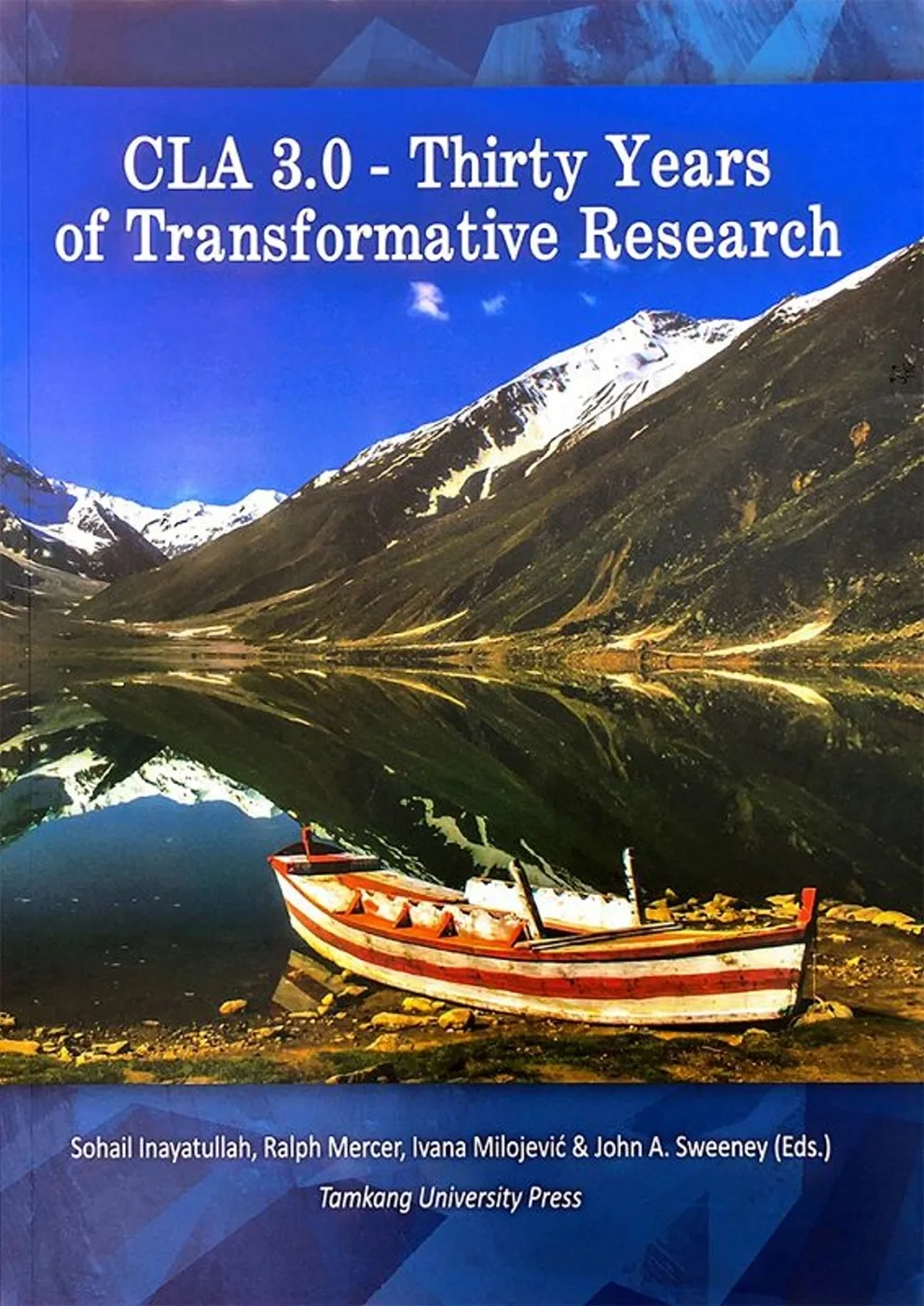- 定價93.00元
-
8
折優惠:HK$74.4

|
|
|
|
CLA 3.0-THIRTY YEARS OF TRANSFORMATIVE RESEARCH
|

|

沒有庫存
訂購需時10-14天
|
|
|
|

|
|
9786267032305 | |
|

|
|
Sohail Inayatullah,Ivana Milojevic,John Sweeney,Ralph Me | |
|

|
|
淡江大學出版中心 | |
|

|
|
2022年10月28日
| |
|

|
|
200.00 元
| |
|

|
|
HK$ 180
|
|
|
|
|

| |
|
|
|
|
| |
|
|
詳
細
資
料
|
ISBN:9786267032305規格:平裝 / 564頁 / 19 x 26 x 2.82 cm / 普通級 / 單色印刷 / 初版出版地:台灣
|
|
分
類
|
人文社科 > 社會科學總論/研究方法 |
同
類
書
推
薦
|
|
|
內
容
簡
介
|
In 1992, while presenting at the World Futures Studies Federation course on International Development, I shifted my lecture from the typical rehearsed presentation on factors explaining maldevelopment to a real time unpacking/deconstruction of transportation futures. As I, we, worked through the analysis, alternatives organically emerged.? The four levels were: first, the problem or the litany – congestion and pollution. Second the causes: too many cars and desire for more cars, rising incomes, traditional infrastructure that was not car flow friendly, among other factors. Third, the Big City outlook, westernization, and the "Los Angelization" of the planet. And fourth, West is best with cars as freedom, as individuality. We understood that the government would take a technical approach of creating flyovers and not the deeper required to rethink centre-periphery relations – to decentralize - to reimagine Bangkok as a walkable and green city. This led to a discussion on not just infrastructure redesign but stories around rural areas and the symbol of the car as a symbol of Western power. CLA shifted the discussion from conventional strategies on transport toward alternative futures of mobility, identity, and sustainability.? After a few more attempts at presenting on communication, on disability, on ways knowing the method was born. Theoretically, of course, I was standing on the works of the greats: P.R. Sarkar, Johan Galtung, William Irwin Thompson, Joseph Campbell and from insights from professors and colleagues such as James Dator, Michael Shapiro, and Richard Slaughter.
In the CLA Reader published in 2004, we compiled articles on the method to gain academic respectability. Doctoral students would email me and say, they wanted to write their thesis on CLA but their professors were suspicious. By 2015, when CLA 2.0 was released, we had documented hundreds of additional case studies. Professor were no longer suspicious, indeed, many enthusiastic. The method by that time had been used by thirty plus national governments, dozens of international organizations, hundreds of businesses and community organizations, and thousands of individuals.
With CLA 3.0, we have moved from planting seeds about a new method, to nurturing young trees, to watching a true forest of transformative and critical futures research. The forest true to the iceberg image that has been linked to CLA is not just on land but in the ocean as well.
My own work in the area has somewhat changed. Along with projects using CLA on the external world, for example, in the past few months, with FAO, Australia Prudential Residential Authority, Mitsubishi Motors, WHO, the Pacific Community, the Razak School of Government, LEGO, UNESCAP, more and more I insist that participants in workshops also focus on the CLA of the self. This has become especially important with the rise in anxiety from COVID and the invasion of Ukraine. The inner work leads not only to the reflective practitioner but ensures epistemological mindfulness. We enter the room aware that we are part of the problem or solution, that our stories can help or hurt. CLA of the self, for me, is a way to help others find ways out of current predicaments. For example, just recently with colleagues in Shanghai stuck from the long lockdown, we worked together to shift the core metaphor from "the prison" to "painting the prison" and from a "lone firefly to a ray of light" connecting with other rays. An educational leader working with the disadvantaged used CLA? recently to develop the new story he wished to tell his community of students, teachers, and parents.? While he understood the reality of admiring the problem, after the CLA workshop, he changed his focus from the victim to the champion. When I suggested that the narrative of the champion might be a step to far, he added an intermediate narrative shift: getting in the game. These storis assist in expanding agency, in helping us create more desirable futures. The stories as with external CLA need to link to systemic changes as well, and when possible, new measures of success.? The question I ask organizations as they develop their new narrative is who are you in the story? Thus, it is not about changing others per se but how about finding a voice, a role for oneself in a changing world. With one large group, their new story was a flotilla of canoes. I then asked participants, who were they in the flotilla? One said, the navigator, another the one who painted the canoes, a third, the one who found dollars for canoe maintenance. The story thus connected all. CLA, for me, is not about strategic foresight but transformational futures. We are in the universe not as objective change agents but as characters (often pre-scripted and used) with the possibility of inner and outer transformation, of co-creating alternative futures.? Depth assists us in moving from technical litany systemic fixes to longer term worldview and narrative shifts.
This book can be read from the position of theories of knowledge, as methodology, as case studies, or as part of ones individual journey. I can only recommend that you work from multiple positions, and, of course, work at all four levels.? While CLA 2.0 was a partnership between me and Director of Metafuture, Dr. Ivana Milojevi?, we are fortunate to now have Drs. John Sweeney and Ralph Mercer as fellow collaborators on this inner and outer, land and ocean voyage.
|
|
目
錄
|
Table of Contents
Foreword?? ?5
CREATING THE FOREST OF TRANSFORMATIONAL FUTURES:?? ?5
THIRTY YEARS OF CLA?? ?5
About the Editors?? ?7
Preface?? ?8
Ivana Milojevi??? ?8
THEORY?? ?13
Sohail Inayatullah, Causal Layered Analysis: Theory, Conceptual Framework, and Method?? ?14
DISCIPLINARY AND METHODOLOGICAL REFLECTIONS:?? ?30
Veli Virmajok, Understanding Futures of Science: Connecting Causal Layered Analysis and Philosophy of Science?? ?31
Russell Clements, Using Gregory Bateson’s Epistemology of Mind and Causal Layered Analysis to Mitigate Asian Elephant-human Conflict Risk.?? ?56
Joseph Corneli, Alex Murphy, Raymond S. Puzio, Leo Vivier, Noorah Alhasan, Vitor Bruno, Charlotte Pierce, Charles J. Danoff, Patterns of Patterns: A Methodological Reflection on the Future of Design Patterns Methods.?? ?88
Peter Scupelli, Does When and How Design Students Learn Causal Layered Analysis Matter??? ?114
Nele Fischer and Konstanti Marquardt, Encounters on the Metaphorical Level: Introducting Systemic Metaphor Analysis for CLA?? ?132
APPLICATIONS:?? ?140
Ivana Milojevi?, Australian Riot: Causal Layered Analysis for Conflict Resolution?? ?141
Adam Cowart, " Living Between Myth and Metaphor:? Level 4 of Causal Layered Analysis Theorised?? ?154
John A. Sweeney, Not Organic Gardening or Rocket Science: New Metaphors (and a Politics) for Geoengineered Imaginaries.?? ?164
Marcelle Holdaway, Diving in the Deep End: Visually Exploring Community Views on Corporate Accountability.?? ?177
Sanna Ketonen-Oksi, Creating a shared narrative: The use of causal layered analysis to explore ecosystem level value co-creation?? ?191
Peter Sukhorolsky, Russian Aggression Against Ukraine: Past, Present, and Futures?? ?208
Niedbalski, The Hong Kong Protests and Tianxia: The Origins of Modern conceptions of Chinese Identity and the struggle for a different future?? ?218
Marcus Anthony, WWW: Web Wide Warfare Part 2: Towards a Deeper Healing of the Online Culture Wars?? ?237
Elissa Farrow, To Augment Human Capacity – Artificial Intelligence Evolution through Causal Layered Analysis?? ?256
Oluseyi Julius Adbowale and Justus Ngala Agumba, Causal Layered Analysis of Construction Labour Productivity in Developing Countries?? ?273
Lazaro et al., Using CLA to participatively explore the urban solid waste problem in Uruguay: three years after?? ?291
Sterling Jackson, Applying Futures Based Frameworks for Emerging Sector Investments: Applying Causal Layered Analysis to Develop Decision Making Metaphors for Risk Forward Investments?? ?303
Rieta Ganas, Kasturi Behari-Leak, Nalini Chitanand, Siya Sabata, Pedagogies for Critical Agency: Portals to Alternative Futures.?? ?310
Matti Minkkinen, Sirkka Heinonen, and Marjukka Parkkinen, Drilling and Blasting to Learn Scenario Construction – Experimenting with Causal Layered Analysis as a Disruption of Scenario Work?? ?328
Jeanne Hoffman, Imagining 2060: A Cross-Cultural Comparison of University Students’ Perspectives?? ?340
Ali Zackery, Mohsen Taheri Damneh, Alireza Karimi, Maryam Ebadi Nejad: Insights from a Causal Layered Analysis of “Isfahan 2040”: A Participatory Foresight Workshop?? ?359
Chris Riedy, Interior transformation on the pathway to a viable future?? ?377
Ralph Mercer: Self-Writing: A Causal Layered Analysis prospective on the Learning Identity Framework.?? ?392
Glossary?? ?399
Index?? ?400
Bonus material?? ?401
Back material?? ?402
?
|
|
|
書
評
|
|
|
|
|

